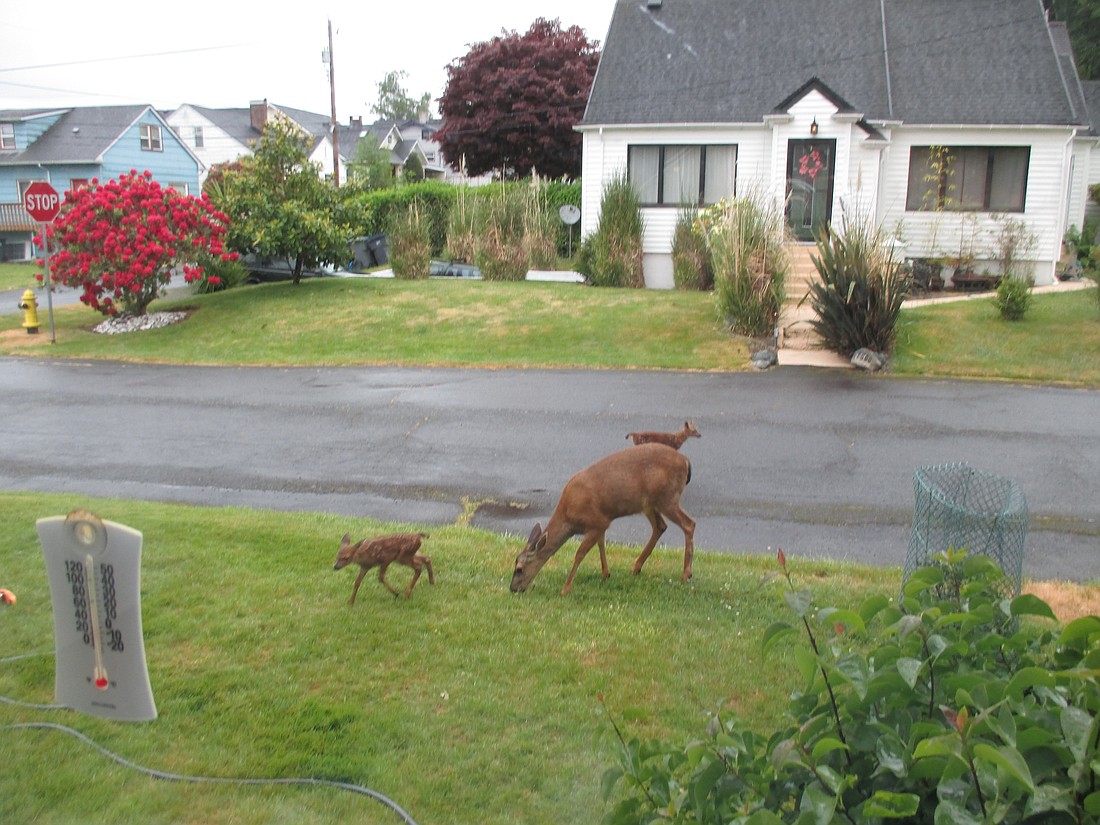NO BREAD
Feeding Deer
Sharing Stories
September 10, 2023 at 6:00 a.m.
...by Ariele M. Huff
Last year, when our apple and plum trees produced exactly zero fruit, we decided to supplement the deer browse during winter. In the previous couple of snowy winters, we’d bought a bag or two of deer mix food like Critter Crunch (corn, peanuts, sunflower seeds, raisins) to help our four-legged visitors. We knew not to approach them because of hooves and horns and, importantly, to keep from making them feel less self-protective with people. We NEVER feed them out of our hands or attempt to pet them.
And here’s the first hint I discovered by going through the internet, reading packaging, and asking neighbors. The hint is that if you put out food, you should also put out water to help wash the harder foods through. Google experts said to keep it some kind of a distance from the food and change it often enough to be clean.
Apparently, the best times to have food out are at dawn and dusk, when they typically browse. Also, the time when there are fewer vehicles and people outdoors.
After we’d gotten a few good-sized groups where a few fought over the food, I began to throw out the browse right after getting up and right before turning in. That way, the food was more like wild growing plants instead of something they were coming up to the windows and begging for.
Reading further, I discovered that deer are as fragile internally as they look externally. NEVER feed deer bread or anything made of flour. A single slice of bread can KILL a deer. Too much hard corn can also cause them indigestion to the point of death. Hay is another surprising one. It is so lacking in nutrition that deer can starve to death with a gut full of hay. Word to the wise. Beyond that, people say oatmeal is fine, but I’ve never met a deer that ate it, or carrots. The looks they give are kind of “What do you think we are? Horses?”
Don’t experiment. They eat apples, grapes, blueberries, cranberries, raisins, even bananas if need be, and really adore nice ripe pears. If you want to see a deer roll its eyes to heaven, ripe pears are the key. Per dry corn mixes, once they get damp, throw them out as they’ll get moldy and then they'll be off the list of safe foods.
Other concerns, laws differ about feeding deer. Check out your area. (I think putting out water during hot weather will never be an issue.) Also,use a little fencing to protect your flowers or plants that deer might like to eat. They love roses, several kinds of flowers, and the bucks use small trees to rub the velvet off their horns. In our yard, I grow oregano, sage, rosemary, English and Spanish lavenders, and arugula. No deer have had ANY interest in those plants. They do trim some larger bushes…a plus, and they DO eat ticks—off themselves and their fawns and friends as well as in the grass.
They do leave tidy piles of small black poop balls. Much easier and less stinky than dog doo. (We use a long-handled scooper.)
Keep in mind that your neighbors will either be onboard or not. For the sake of the deer as well as your relationship, you might need to move your goodies further from the fence.
Finally: This has become one of our favorite hobbies—not cheap but so rewarding. Some mamas that recall us have brought their fawns to show off. One doe has chosen a shady spot next to our west wall as the place where she leaves her two babies while she goes off for a break. As frisky as they are when she’s with them, while we babysit, they stay exactly in the same place…in spite of the occasional car or walker going by. Good babies!
Ariele Huff leads ZOOM writing groups. Connect for a flyer at ariele@comcast.net..
SHARING STORIES is a weekly column for and about the 50 plus crowd living in the Puget Sound region. Send your stories and photos to ariele@comcast.net. Tell local or personal stories; discuss concerns around aging and other issues; share solutions, good luck, and reasons to celebrate; poems are fine too. Pieces may be edited or excerpted. We reserve the right to select among pieces. Photos are always a plus and a one-sentence bio is requested (where you live, maybe age or career, retired status, etc.).
SHARING STORIES is featured on www.northwestprimetime.com, the website for Northwest Prime Time, a monthly publication for baby boomers, seniors, retirees, and those contemplating retirement. For more information, call 206-824-8600 or visit www.northwestprimetime.com. To find other SHARING STORIES articles on this website type "sharing stories" in the search function above.





